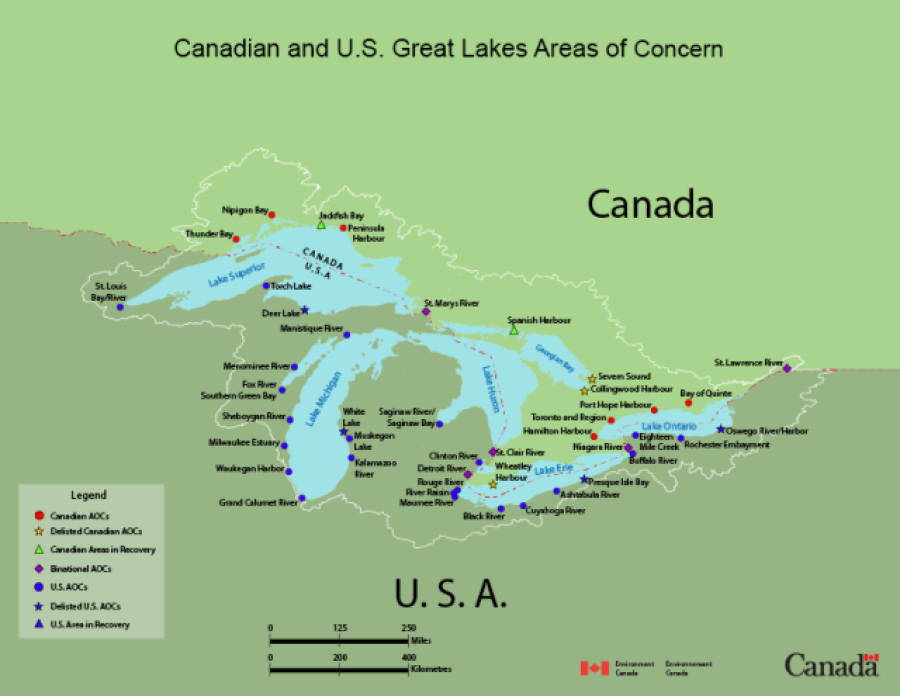Canada lags behind the U.S. on spending to protect the Great Lakes
The federal government says it's making Canada's largest investment ever in protecting the nation's sources of fresh water — including the Great Lakes.
Commitments announced by the government during U.S. President Joe Biden's visit and in the recent budget bring the federal government's total investment to $750 million, said Environment Minister Steven Guilbeault.
"[It brings] us very close to our commitment to invest $1 billion ... in this mandate. So we're not quite there yet," he told CBC News.
The government announced during Biden's visit it will be spending $420 million to clean up and restore the Great Lakes. That money is part of the $750 million total.
During the 2021 election campaign, the Liberals committed to spending more than $1 billion over ten years to protect and restore freshwater bodies, including rivers, large lakes and the Great Lakes.
Last week's budget earmarked $650 million over ten years for the Fraser River, the Mackenzie River, Lake Winnipeg, the Lake of the Woods, Lake Simcoe, the St. Lawrence River and the Great Lakes.
The money is intended to support monitoring, assessment and restoration work, to prevent the release of harmful chemicals and to reduce the frequency of algae blooms.
Canada's freshwater sources face ongoing threats from plastic and toxic chemical pollution, algae blooms from excessive agricultural fertilizer runoff, and invasive species. In the Prairies, they're threatened by shrinking glaciers and drought.
These threats affect plant and aquatic life and the communities that rely on these bodies of water for drinking water and recreation. Canada is home to 20 per cent of the planet's supply of fresh water; Guilbeault said Canada hasn't always lived up to the responsibility.
And he admits Canada needs to catch up to U.S. investments in freshwater source protection and restoration.
"[The Americans] have, in the past few years, made very significant investments early in the Great Lakes," Guilbeault said. "We had made the commitment to invest more."
Michelle Woodhouse, program manager for water at Environmental Defence, agreed Canada needs to match U.S. efforts to protect the Great Lakes.
"Very fair to say we have been lagging behind," she said, "It has been decades of chronic underfunding."
According to calculations by environmental groups, the United States has invested $3.8 billion US in the Great Lakes Restoration Initiative since 2010. By comparison, the Canadian government has allocated $44.84 million to the Great Lakes Protection Initiative. Even on a per capita basis, Canada is trailing.
Environmental groups and U.S. mayors applauded Canada's funding commitment, despite the gap.
"Representing an international border community on the shoreline of the Great Lakes, I am thrilled to see this kind of cooperation and coordination between the U.S. and Canadian governments to enhance the health of the Great Lakes," said Detroit Mayor Mike Duggan in a statement from the Great Lakes and St. Lawrence Cities Initiative.
The Toronto and Region Conservation Authority (TRCA) manages the nine watersheds that run through the Greater Toronto Area.
In 1987, the Toronto waterfront was named as one of 42 areas of concern by the International Joint Commission. The IJC is a bi-national commission established by Canada and the U.S. to regulate cross-border projects that affect water bodies along the border. The IJC identifies "areas of concern" as locations within the Great Lakes that have experienced high levels of environmental damage.
Since then, the TRCA has been working to clean up Lake Ontario. Although it has made progress, it still has to close beaches occasionally and deal with algae blooms and concerns about wildlife habitat. The TRCA also maintains restrictions on fish consumption.
Namrata Shrestha, a senior manager at the TRCA, said investments by the federal government are welcome.
"We do have a lot of issues with our Great Lake system, especially Lake Ontario," Shrestha said. "There a lot of issues on water quality and its implications on not just the ecosystem per se … but also the cascade effect of it, of what that means for us as a community."
The Toronto waterfront is among 12 of 14 Canadian areas of concern that Environment and Climate Change Canada is promising to clean up by 2030. The department says that over the next decade, it will focus on the following contaminated or degraded areas:
- Thunder Bay
- Nipigon Bay
- Peninsula Harbour
- St. Mary's River
- St. Clair River
- St. Clair River
- Detroit River
- Niagara River
- Hamilton Harbour
- Toronto and region
- Bay of Quinte
- St Lawrence River
Three Canadian areas of concern have already been restored and delisted: Collingwood Harbour, Severn Sound and Wheatley Harbour.
By David Thurton
CBC Senior reporter














